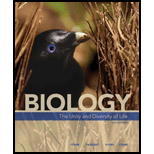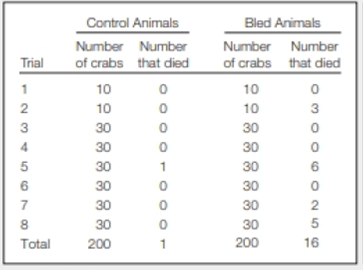
Concept explainers
Sustainable Use of Horseshoe Crabs Horseshoe crab blood clots immediately upon exposure to bacterial toxins, so it can be used to test injectable drugs for the presence of dangerous bacteria. To keep horseshoe crab populations stable, blood is extracted from captured animals, which are then returned to the wild. Concerns about the survival of animals after bleeding led researchers to do an experiment. They compared survival of animals captured and maintained in a tank with that of animals captured, bled, and kept in a similar tank. FIGURE 24.28 shows the results.

FIGURE 24.28 Mortality of young male horseshoe crabs kept in tanks during the 2 weeks after their capture. Half the animals were bled on the day of their capture. Control animals were handled, but not bled. This procedure was repeated 8 times with different sets of horseshoe crabs.
Looking at the overall results, how did the mortality of the two groups differ?
Want to see the full answer?
Check out a sample textbook solution
Chapter 24 Solutions
Biology: The Unity and Diversity of Life (MindTap Course List)
- I’m struggling with this topic and would really appreciate your help. I need to hand-draw a diagram and explain the process of sexual differentiation in humans, including structures, hormones, enzymes, and other details. Could you also make sure to include these terms in the explanation? • Gonads • Wolffian ducts • Müllerian ducts • Testes • Testosterone • Anti-Müllerian Hormone (AMH) • Epididymis • Vas deferens • Seminal vesicles • 5-alpha reductase • DHT • Penis • Scrotum • Ovaries • Uterus • Fallopian tubes • Vagina • Clitoris • Labia Thank you so much for your help!arrow_forwardI’m struggling with this topic and would really appreciate your help. I need to hand-draw a diagram and explain the process of sexual differentiation in humans, including structures, hormones, enzymes, and other details. Could you also make sure to include these terms in the explanation? • Gonads • Wolffian ducts • Müllerian ducts • Testes • Testosterone • Anti-Müllerian Hormone (AMH) • Epididymis • Vas deferens • Seminal vesicles • 5-alpha reductase • DHT • Penis • Scrotum • Ovaries • Uterus • Fallopian tubes • Vagina • Clitoris • Labia Thank you so much for your help!arrow_forwardOlder adults have unique challenges in terms of their nutrient needs and physiological changes. Some changes may make it difficult to consume a healthful diet, so it is important to identify strategies to help overcome these obstacles. From the list below, choose all the correct statements about changes in older adults. Select all that apply. Poor vision can make it difficult for older adults to get to a supermarket, and to prepare meals. With age, taste and visual perception decline. As people age, salivary production increases. In older adults with dysphagia, foods like creamy soups, applesauce, and yogurt are usually well tolerated. Lean body mass increases in older adults.arrow_forward
- When physical activity increases, energy requirements increase also. Depending on the type, intensity, and duration of physical activity, the body’s requirements for certain macronutrients may change as well. From the list below, choose all the correct statements about the effects of increased physical activity or athletic training. Select all that apply. An athlete who weighs 70 kg (154 lb) should consume 420 to 700 g of carbohydrate per day. How much additional energy an athlete needs depends on the specific activity the athlete engages in and the frequency of the activity. Those participating in vigorous exercise should restrict their fat intake to less than 15%% of total energy intake. Athletes who are following energy-restricted diets are at risk for consuming insufficient protein. The recommendation to limit saturated fat intake to less than 10%% of total energy intake does not apply to athletes or those who regularly engage in vigorous physical activity.arrow_forwardWhen taking vitamins and vitamin-mineral supplements, how can one be sure they are getting what they are taking?arrow_forwardHow many milligrams of zinc did you consume on average per day over the 3 days? (See the Actual Intakes vs. Recommended Intakes Report with all days checked.) Enter the number of milligrams of zinc rounded to the first decimal place in the box below. ______ mg ?arrow_forward
- the direct output from molecular replacement is a coordinate file showing the orientation of the unknown target protein in the unit cell. true or false?arrow_forwardthe direct output from molecular replacement is a coordinate file showing the orientation of the unknown target protein in the unit cell. true or false?arrow_forwardDid your intake of vitamin C meet or come very close to the recommended amount? yes noarrow_forward
- Which of the following statements about hydration is true? Absence of thirst is a reliable indication that an individual is adequately hydrated. All of these statements are true. Although a popular way to monitor hydration status, weighing yourself before and after intensive physical activity is not a reliable method to monitor hydration. Urine that is the color of apple juice indicates dehydration. I don't know yetarrow_forwardThree of the many recessive mutations in Drosophila melanogaster that affect body color, wing shape, or bristle morphology are black (b) body versus grey in wild type, dumpy (dp), obliquely truncated wings versus long wings in the male, and hooked (hk) bristles versus not hooked in the wild type. From a cross of a dumpy female with a black and hooked male, all of the F1 were wild type for all three of the characters. The testcross of an F1 female with a dumpy, black, hooked male gave the following results: Trait Number of individuals Wild type 169 Black 19 Black, hooked 301 Dumpy, hooked 21 Hooked, dumpy, black 172 Dumpy, black 6 Dumpy 305 Hooked 8 Determine the order of the genes and the mapping distance between genes. Determine the coefficient of confidence for the portion of the chromosome involved in the cross. How much interference takes place in the cross?arrow_forwardWhat happens to a microbes membrane at colder temperature?arrow_forward
 Biology: The Unity and Diversity of Life (MindTap...BiologyISBN:9781305073951Author:Cecie Starr, Ralph Taggart, Christine Evers, Lisa StarrPublisher:Cengage Learning
Biology: The Unity and Diversity of Life (MindTap...BiologyISBN:9781305073951Author:Cecie Starr, Ralph Taggart, Christine Evers, Lisa StarrPublisher:Cengage Learning Biology: The Dynamic Science (MindTap Course List)BiologyISBN:9781305389892Author:Peter J. Russell, Paul E. Hertz, Beverly McMillanPublisher:Cengage Learning
Biology: The Dynamic Science (MindTap Course List)BiologyISBN:9781305389892Author:Peter J. Russell, Paul E. Hertz, Beverly McMillanPublisher:Cengage Learning Biology Today and Tomorrow without Physiology (Mi...BiologyISBN:9781305117396Author:Cecie Starr, Christine Evers, Lisa StarrPublisher:Cengage Learning
Biology Today and Tomorrow without Physiology (Mi...BiologyISBN:9781305117396Author:Cecie Starr, Christine Evers, Lisa StarrPublisher:Cengage Learning Biology (MindTap Course List)BiologyISBN:9781337392938Author:Eldra Solomon, Charles Martin, Diana W. Martin, Linda R. BergPublisher:Cengage Learning
Biology (MindTap Course List)BiologyISBN:9781337392938Author:Eldra Solomon, Charles Martin, Diana W. Martin, Linda R. BergPublisher:Cengage Learning Biology 2eBiologyISBN:9781947172517Author:Matthew Douglas, Jung Choi, Mary Ann ClarkPublisher:OpenStax
Biology 2eBiologyISBN:9781947172517Author:Matthew Douglas, Jung Choi, Mary Ann ClarkPublisher:OpenStax





